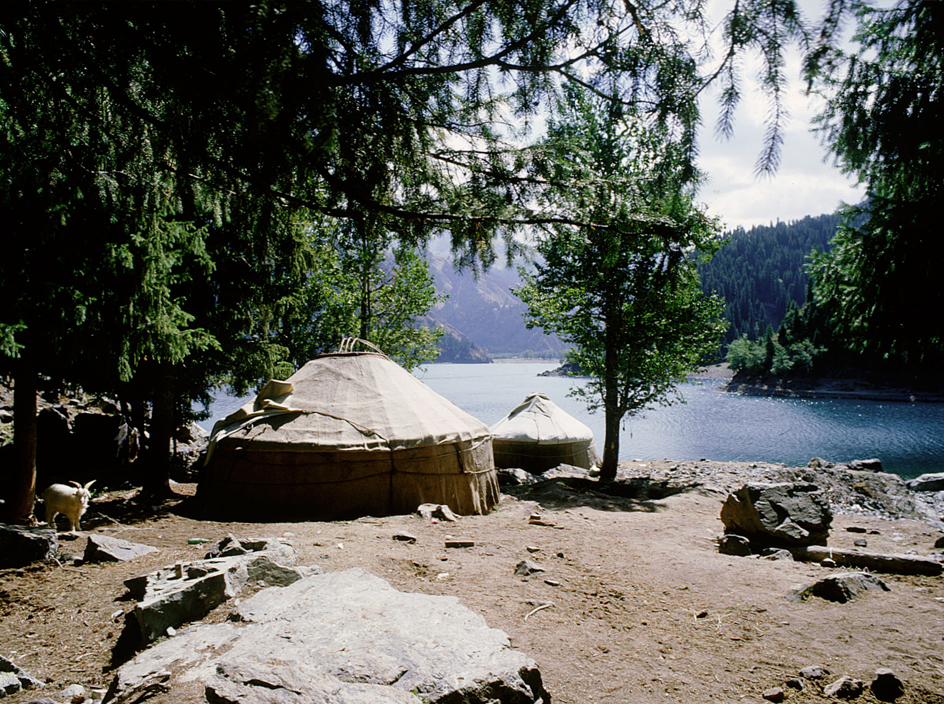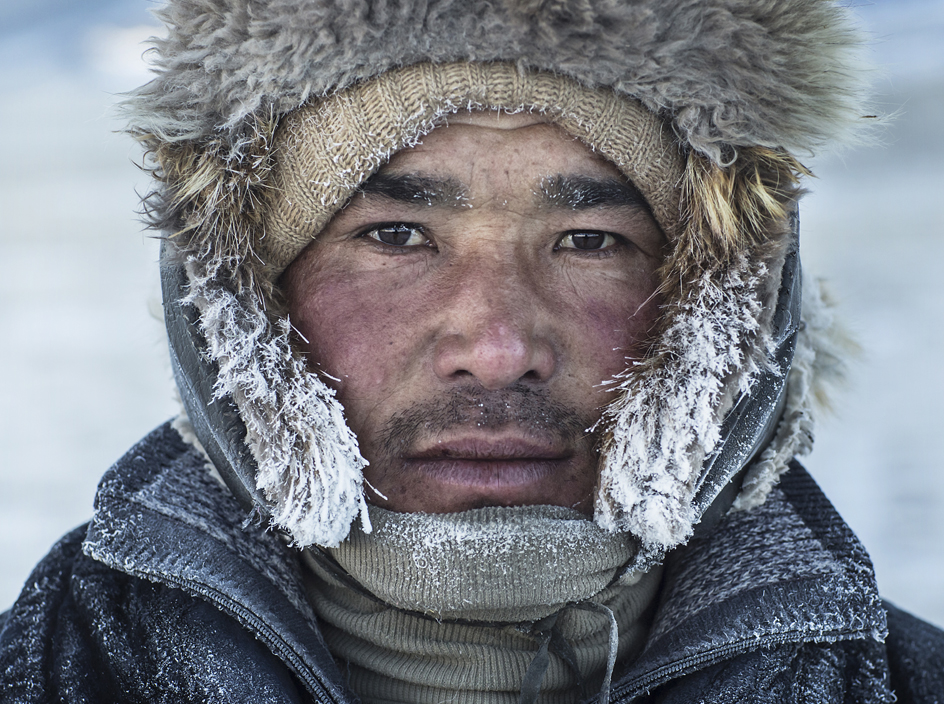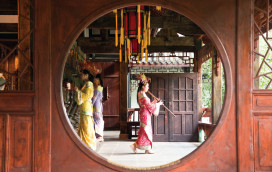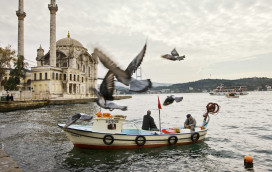In the Tian Shan Mountains – the Mountains of Heaven, to the Chinese – my guide and I came upon an old man on a white horse. He wore tall leather boots and a splendid white felt hat like an upturned jelly mold. With a jerk of his head, he invited us to come and eat. Beyond San Tash, where Tamerlane left a chilling monument to his slaughtered dead, we found his yurt perched on a bluff above a dark river. Full of the aromas of cooking and wood smoke, it was as snug as a womb. We took our place sprawled on rugs on a raised platform at the rear. Bowls of milky tea laced with butter were handed round and a great plate of petrified cheese was set before us.
The old man’s flat Kyrgyz face was the color of walnuts. He gazed at me for a moment without speaking, as if assessing my fate. Then he set about eating, chomping his way through the bread and cheese with a series of deep, throaty growls, before throwing himself back onto the pillows with a grunt and looking at me. “ENGLISH!” he bellowed at me. (I’m not English, but this didn’t seem the moment to quibble about passport details.) “ENGLISH, WHERE IS YOUR WIFE?”
I thought for a dreadful moment he knew something about my wife that I didn’t, that he had heard she had run away to the South of France with a member of the Chippendales. Then I remembered I didn’t have a wife.
“No wife,” I said, relieved.
He made a pantomime expression of surprise. His eyes, the color of tea, widened to the size of saucers.
“NO WIFE?” he bawled. Then his voice dropped to pianissimo. “Listen carefully, English. Let me tell you how to get a wife.” And leaning back, he embarked upon an explanation of the intricacies of Kyrgyz romance.
I was on the Silk Road, that great trans-Asian route that the English traveler Freya Stark described as “the oldest, the longest, the most romantic, the most persistent of all the checkered streams of trade”. For more than 4,000 miles, it follows various routes from the gates of Xi’an in China to the shores of the Mediterranean. But whichever way you pass, Central Asia is its hub, and the people of Central Asia its middlemen. They share nomadic roots, mercantile instincts and a surprising enthusiasm for splendid hats, from the dainty pillbox job of the Uzbek merchant to the tall felt affair of the Kyrgyz horseman.
I had come to Central Asia to understand nomads, and to see the remnants of the nomadic culture that still existed in the remoter regions of Kazakhstan and Kyrgyzstan. I was following the route of the old Silk Road, from the Crimea across southern Russia, watching the rolling steppes from the windows of the Kazakhstan Express. I left the train in the town of Turkestan, where dust from the Kyzylkum Desert coated the leaves of the shade trees along the main road.
Turkestan is home to one of the holiest of Kazakh shrines, the mausoleum of the first great Turkic saint, Khoja Ahmed Yasawi, the founder of a Sufi order in the 12th century. Its blue dome rises on the edge of the desert, the sole survivor of the town’s more glamorous past. It was built by one of the great names of Central Asia: Tamerlane, the 14th-century conqueror who traced his ancestry back to Genghis Khan.
The mosque encapsulates the true essence of the Silk Road. Ideas were packed among the goods in the baggage trains on this legendary route. Culture, art and religion passed from one region to another with breathtaking fluidity. Islam spread here from the Middle East – and the ribbed dome of this shrine is part of the great canon of Iranian architecture, an influence that had traveled eastward along the Silk Road for well over 600 miles. The dome hovers above walls of turquoise and azure tiles and delicate traceries of arabesque. I followed passageways from the central chamber into a labyrinth of tall white rooms, the grilled windows of which filtered the outside world to a pale wash of light and a filigree of muted sound. No other religion has captured the longing for a tranquil soul in the form of architecture as exquisitely as Islam.
To the south of Turkestan lie the ruins of Otrar, another ghost on the Silk Road, and the place where Genghis Khan, the great nomadic conqueror, got his start in the business of empire-building. Just beyond a museum cataloging the life of this once-great city, a long featureless mound topped by waves of corn, littered with pot shards and bleached bones. In an excavation pit, where swallows rose in a fluttering cloud, I found the floor of Otrar’s great mosque. All that remained were the shattered bases of brick columns. The layers of sediment exposed in the pit walls showed the strata of the city’s different eras of settlement. Among them, a thick line of ash marked the Mongol era, when Genghis Khan had sent armies to burn this city to the ground, at the very beginning of the Mongol Empire.
This conflict between the settled people of cities and the nomadic horsemen of the steppes is one of the central issues of the Silk Road. Time and again, nomads would sweep east and west along the road to conquer settled populations – in China, in Persia, in northern India. Here, in this archaeological pit, in this layer of burnt material, was a moment in history that you could touch. I raked my fingers over it, and the old ash, the ancient antipathies, crumbled onto my boots.
In the congested avenues of Almaty, Kazakhstan’s former capital, I found myself sympathizing with the nomads. The city was full of city hassles – queues, crowds, traffic. In the midday heat, people seemed to move in sluggish slow motion. But when I lifted my eyes beyond the buildings and the rooftops, I could see the mighty Mountains of Heaven, the mighty Tian Shan. They promised escape.
So I set off with a guide, the bumbling Marat, to Kyrgyzstan, and that section of the old road that ran along the northern shores of Issyk-kul lake towards the mountain passes to China. In Bishkek, the Kyrgyz capital, the main avenue was still called Silk Road Street. Eastwards, the road ran through velvet foothills. Gangs of hay-makers were out in the fields with pitchforks and scythes. On the far side of a pass of poplars and rose-colored rocks, huge flocks of sheep appeared, with young shepherds on horses cracking long whips in the rolling clouds of dust.
We passed the 11th-century Burana Tower, like a lighthouse of the Silk Road, marooned in fields of edelweiss. It marked the ruins of Balasagun, a millennium ago a great Silk Road city. In the small museum were the remnants of the ancient trade: Chinese coins, bracelets of Indian cowrie shells, iron swords, bronze lamps, amulets. In the late afternoon, we came down to Issyk-kul. Its glassy surface held the reflections of snow peaks and high wind-torn clouds. A family went by in a wagon, the patriarch in a tall felt hat, reclining on bolsters of new hay among a tribe of daughters. At the end of the lake we drove through apple orchards to Karakol. Tucked away in one of the remotest corners of Central Asia, the town of Karakol still had the cosmopolitan air of a Silk Road town, a place where disparate peoples met and mingled. Blond Russian schoolchildren were trailing home past cottages with blue shutters and white picket fences. Uighurs in their pretty embroidered caps had laid out cheap Chinese imports at makeshift stalls in the main square. In the market, Uzbek butchers were dismembering cows with huge axes. Kazakh men went by on tall horses while old Kyrgyz men with wispy beards gossiped on shady street corners.
The next morning, Marat and I took up the trail of Tamerlane, heading east into the Tian Shan mountains. Born in Central Asia, Tamerlane, or Timur, was the last of the great nomadic conquerors, forging an empire in the 14th century that stretched westward along the Silk Road into Iran and much of the Middle East as well as southward into northern India and north into much of Russia. In Samarkand, his capital, he left one of the world’s most beautiful ensembles of Islamic buildings – a model of architectural delicacy and sophistication. Everywhere else, from Baghdad to Delhi, he left vast piles of bones.
We rose into high valleys of grass and pine trees, of horsemen and nomads. On the far side of a narrow pass, we came to the valley of Karkara. It was empty and pristine and full of birdsong. A herd of untended horses were galloping through blue twilight. China lay just beyond the passes.
Halfway along the valley floor, we came to the great mound of San Tash, a pile of boulders the height of a house. It was made when Tamerlane embarked on an ill-fated invasion of China. He ordered each soldier to place a stone on the pile as they passed. On their way back from the wars, each took one away again. In this way, Tamerlane could calculate his losses. They numbered in the thousands, a tall cenotaph of stones raised by the fallen to their own memory. I climbed to the top, and the rocks slipped and rumbled beneath my feet like skulls.
It was here that we met our Kyrgyz nomad, on his white horse. After supper, he embarked on his matrimonial advice. He was a traditionalist in matters of the heart. In his day, Kyrgyz chaps would cut to the chase when it came to courtship. A young man in possession of a Kyrgyz fortune – numerous sheep – and in need of a wife simply kidnapped the woman of his dreams, and then, through intermediaries, made her family an offer they couldn’t refuse. As soon as the bargaining was completed – quantities of sheep generally needed to change hands – they set a date and the young man and his fiancée emerged from hiding to a welcome from both families. The old man sat back, spreading his hands wide. “That’s the way to get a decent wife,” he said, slapping my thigh. His own wife, and former hostage, beamed her approval.
His was the voice of the old Silk Road, of the nomadic cultures that had been central to these regions. But a new Silk Road is emerging in Central Asia. After decades of Soviet hegemony, trade is again becoming the life blood of these regions. A sense of optimism among the new republics of Central Asia, coupled with China’s expansive trade policies, is transforming the region. Rail lines now carry freight from the heart of China across its mountainous western borders to the Central Asian republics and beyond to Iran, to Turkey and to Europe. A new Silk Road is being forged in Central Asia – part of a modern, globalized world.
The great trading caravans of the past nurtured the cities of Central Asia: Merv, Khiva, Bukhara and Samarkand. With the new trading realities, the old cities are prospering again, and new cities are emerging. Among them is Astana, Kazakhstan’s burgeoning capital – a city that now stands at the center of the modern Silk Road. Its gleaming skyscrapers rise confidently from the Kazakh steppe, while luxury hotels like the new St. Regis Astana stand as heirs to the old Silk Road caravanserais.
Your address: The St. Regis Astana
Above: simple lakeside huts in the Tien Shan Mountain range, which straddles the border between China and Kyrgyzstan, present an idyll of peace
(©Getty Images)
Below: trade is booming once again on the Silk Road, where an ancient culture is being connected with the modern world for the benefit of both
(©Getty Images)





